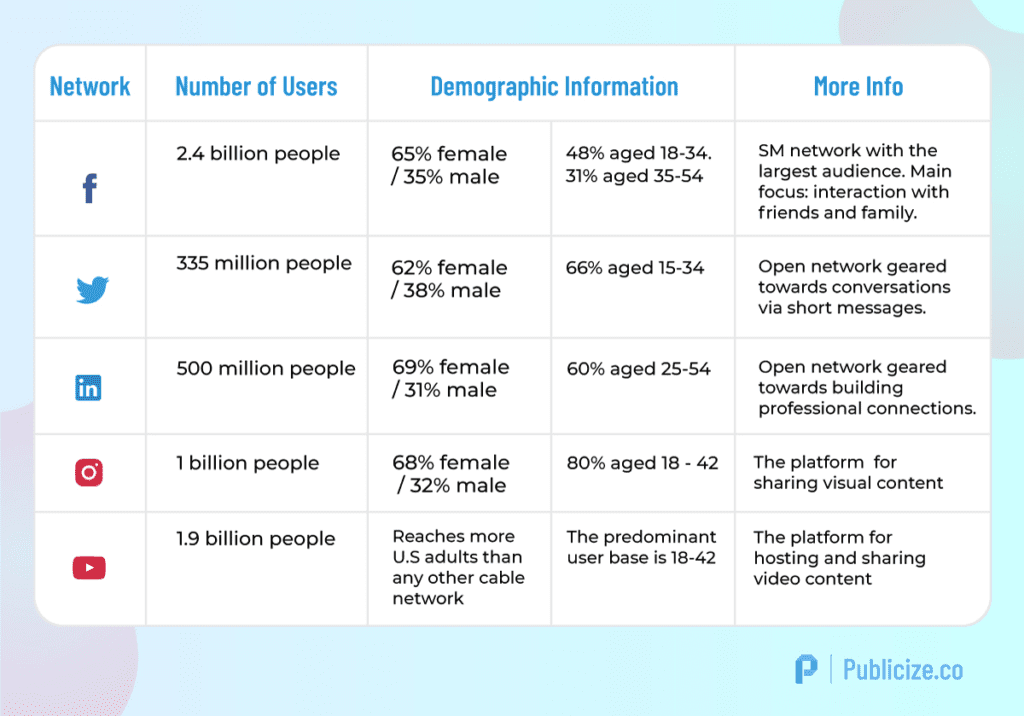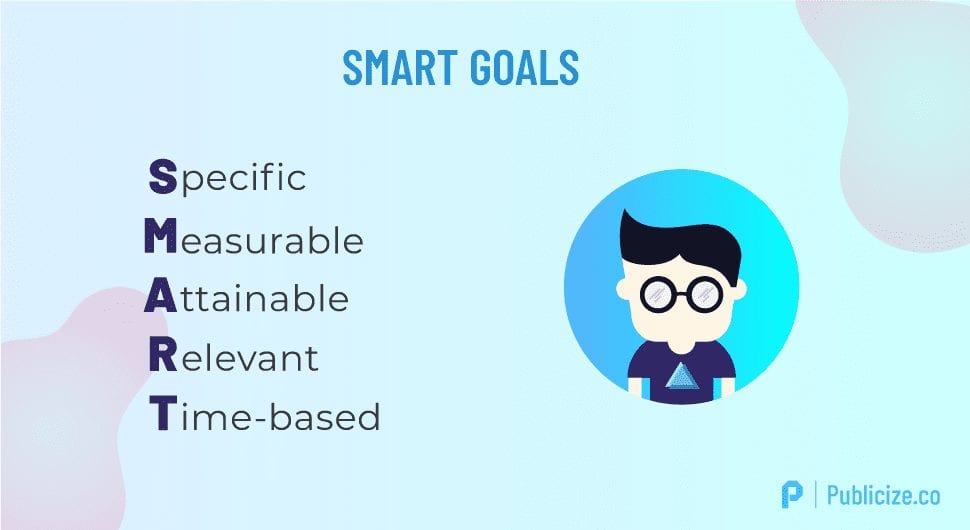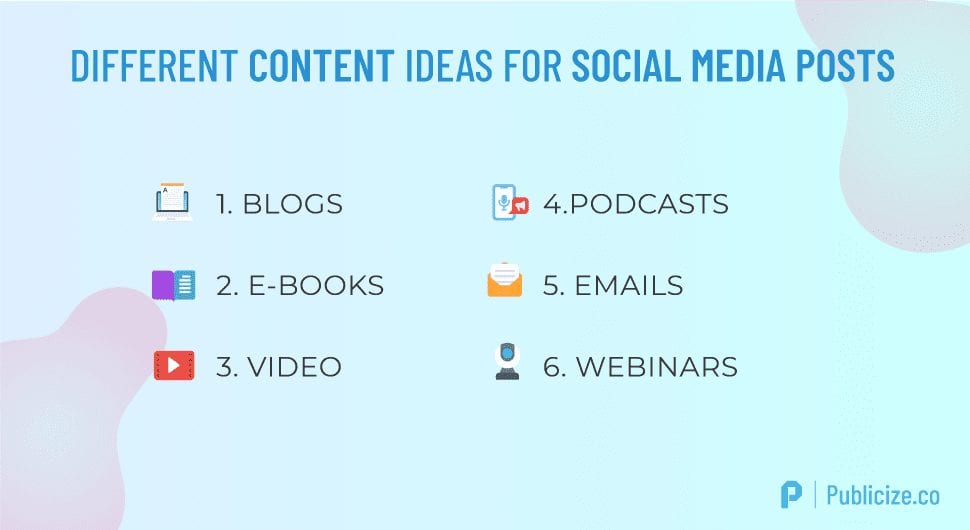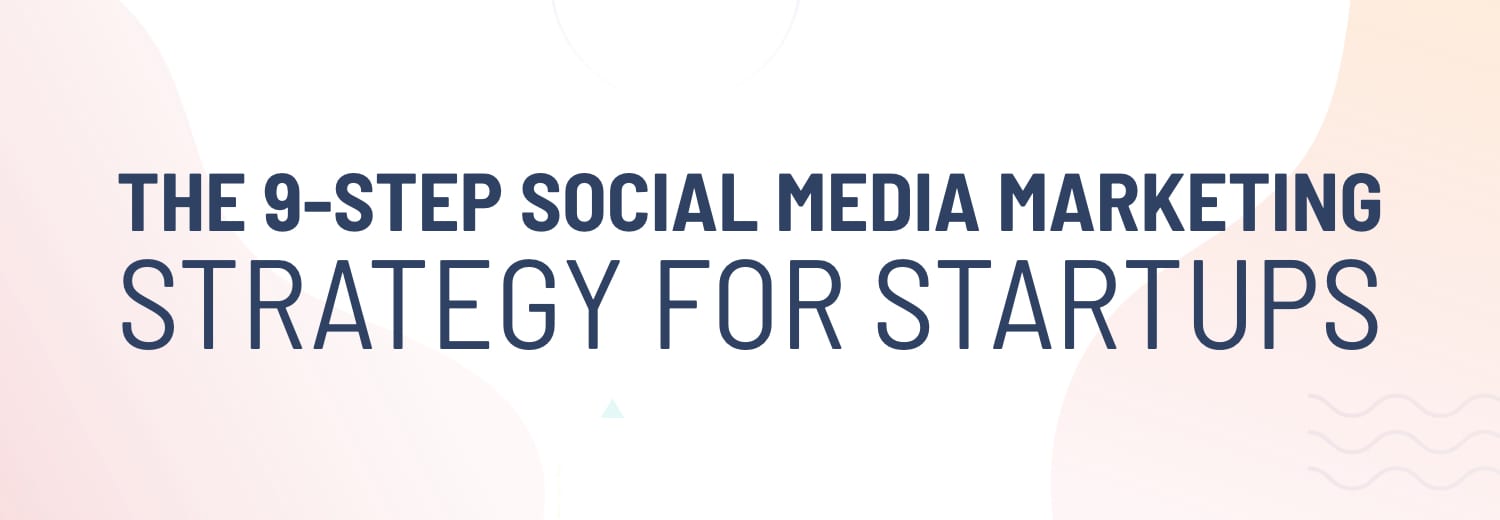Social media marketing is something that startups need to have a strategy for, and quickly.
The importance of social media for startups cannot be underestimated. Over 45% of the world’s population using at least one channel. It’s clear that social media marketing for small businesses is no longer something that can be done on a whim.
With this in mind, we’ve put together this guide with 9 easy steps to get your first social media marketing strategy up and running.

Using social media for marketing
Social media marketing is now one of the most useful and valuable weapons that your startup can use for growth and profit.
Firstly, out of 11 different sources, social networks were found to be the biggest source of consumer inspiration. 37% of people found purchasing inspiration through social media.
If that wasn’t enough, 21% of people are more likely to buy from brands with an active social media presence.
Therefore, it’s vital that you incorporate social media into your startup’s marketing and PR strategy.
What is social media marketing?
In reality, social media marketing is no different from any other marketing channel. And just like any other marketing channel, your goal is to get in front of your target audience.
However, to spell it out:
Social media marketing refers to the process of gaining traffic or attention to your business through your social media sites.
What are the main social media channels for startups?
While there are plenty of niche and special interest social media channels out there, in this guide to social media for startups we’re just going to focus on the big FIVE:
- YouTube
You no doubt already have plenty of experience with each of these channels. However, let’s crunch the numbers and take a closer look at each one:

Why is social media marketing important for startups?
The numbers above underline the importance of social media marketing for startups. It doesn’t matter if your startup is in fintech, blockchain, consumer electronics, or any other sector, the chances are a fair chunk of your target market is going to be active on social media.
But beyond simply “reaching your audience”, here are some specific benefits of social media marketing:
- Improved Brand Awareness – Social media is a great method for initially getting eyes on your startup. Don’t just take our word for it! 91% of marketers agreed that by spending a few hours investing in social media activity each week their brand visibility increased significantly.
- Engaging with customers/your audience – Social media has blurred the lines between marketing, PR, and customer service. This is largely due to the ease in which you can establish a relationship and communicate directly with your audience. Consumers are starting to expect this level of communication, too. For 45% of consumers, social media is one of the first channels they go to with questions or issues.
- Increased website traffic – Social media gives you another place to share your content. This gives your followers a reason to click-through to your website. Keep in mind, the higher quality your content is, the more inbound traffic you’ll receive.
- Benefits your SEO – Social media is a great place to share your owned media content with your audience. There are some whispers (though Google has never confirmed this) that social media shares of website pages are shown to have a positive impact on your website’s SEO. In turn, it may result in you climbing up Google’s rankings.
- Cost-effective – This point is largely down to you. Of course, social media channels offer paid advertising and the budget is down to the account owner. However, when used organically, social media marketing is possibly the most cost-effective method you can use.
- Healthier customer satisfaction – Another note on social media’s impact as a customer service tool. Customers like when they post a comment and receive a modified or personal reply, rather than a computerized one. Take the time to personalize your communications and your audience will see you in a more positive light.
- Great for building brand reputation – A bit of a general one here, but still worth mentioning. The goal of PR is to build the reputation of your brand. Social media can with this. If you satisfy your customers on social media, others may see this and start seeing your company as one to trust. Furthermore, they may start saying positive things about you on their own social media channels. It’s basically free marketing!

Difference between paid and organic social media marketing
With that last bullet point still ringing in our ears, let’s look at the difference between paid and organic social media marketing. The distinction and strategic approach between the two remains a common point of confusion.
The Organic Side
Organic social media is any activity that hasn’t been directly paid for.
When you post anything on your page but you don’t put any money behind the post, you’re creating an organic post.
Simply put: organic actions occur on non-ads.
The Paid Side
Paid social media is anything that is influenced and boosted by advertising. Any post in your feed that has the “Sponsored” tag is commonly referred to as paid social media.
On the whole, paid social media strategies can be tailored to specific demographic and behavioral factors.
Here are some examples of paid social media:
- Boost your posts so they reach a wider audience.
- Optimize your ads for clicks.
- Come up with lead generation forms.
- Use video ads.
Why Use Both?
Many entrepreneurs and business owners firmly believe that organic reach (the number of individuals who come across your post in their feeds) is enough to make an impact. This was to some extent true in the first few years but it’s now no longer the case.
Today, all social media networks are pay-to-play channels.
All of them run on algorithmic feeds, meaning that posts will be shown to users based on their behavior and their preferences instead of chronological order. For example, organic posts on Facebook only reach 2% of a page’s followers and this could continue to decrease.
How to do a Social Media Marketing Strategy for Startups?
The nine steps we’ll cover in this guide will solely focus on organic marketing on social media.
Why is this?
Well, it’s for two reasons:
- If you’re starting from scratch, you need to get your social media profiles in order before spending money on ads
- As a startup, your social media budget is probably relatively lean. Therefore, we want to ensure this guide is as lean as a grilled chicken breast.
Let’s get into it!
Step One: Get goal setting
First things first, you want to set some realistic and attainable goals.
The best way to set goals is to follow the S-M-A-R-T goal-setting acronym. Here’s a handy image to decipher what SMART goals are:

A lot of beginners to social media believe that increasing your number of followers and likes equals success.
Making new friends is always good, but it’s unlikely to be a startup’s primary goal.
Here are some goals that your startup may go after:
- Increasing brand awareness – as we briefly touched upon, social media is great for building brand exposure. This is especially useful if you’re a new startup kicking things off on social media. If you were looking at making this a SMART goal, it might be something like ‘increase facebook followers by 50% in one month’.
- Generate new leads – if you’re looking for new leads, social media can shorten your sales funnels and get you new email subscribers, event RSVPs, and customer details.
- Drive website traffic – Your startup can share blog posts or product pages on social media and lead more visitors to your website.
- Increase sales – This is an especially useful goal if your startup is a b2c ecommerce company.
Step Two: Ask yourself: which social media channels are best for you?
Once you’ve decided what your social media goals are, it’s time to decide which social media channels are best for you.
To make this decision, you want to think about the industry you’re in. For example, say you’re in B2B tech. You would want to target your social media marketing towards business professionals. Therefore, you’d be more inclined to target LinkedIn than Instagram.
To delve deeper into your audience, start trying to identify your target market. Ask yourself some questions, such as:
- What is my customer demographic?
- Which channels are they likely to use?
For instance, say your startup is an eCommerce business that sells boutique clothing online.
Your target audience – or buyer persona – may look something like this:
- Interested in fashion
- Likes visuals
- Has disposable income – more likely aged 18-24
- More likely to be female
With this in mind, you’d want to primarily focus on a social media channel that deals mostly with photos or visuals and have a majority female user base. Therefore, the channel you’d want to use would be Instagram.
Of course, these are all assumptions when you’re at this stage but having some kind of plan and asking these sorts of questions lay vital foundations.
Step Three: Set up your social media profiles
OK, so now we’re gonna get things cooking and set up your social media profiles.
It’s more than likely that you already have some form of social media presence. However, setting up one for a business may differ. That’s why we’ve broken down how to set up an account and the best practices for the five main social media channels.
For Facebook, you’ll need to create a Facebook business page. This can only be done if you have a personal page. If you don’t already have one, then take a few seconds to step one up.
Facebook: Things to consider
- Website URL (provided)
- The company’s physical address
- The company’s phone number
- Profile picture (170 x 170 pixels)
- Cover photo (or animation). (820 x 462 pixels)
- Company description (optimized for SEO)
To create a Twitter account, you’ll need to think of a twitter handle. However, don’t sweat too much over this as it can be changed later.
Twitter: Things to consider
- Profile picture (400 x 400 pixels)
- Bio (160 characters or less)
- Header image (1500 x 500 pixels)
- A pinned tweet (ideally a video about the company, that can be used on YouTube as well)
Similar to Facebook, first you should create a personal account so you can easily create a company page.
LinkedIn: Things to consider
- Description: relevant keywords and phrases that describe the company’s mission and purpose (LinkedIn members can search by keywords, so include words and phrases that describe the business, expertise, and industry focus).
- Profile picture and cover image (same size as Twitter)
- Company info (industry and company size)
This sees you move away from your desktop. To set up an Instagram account, download the Instagram app on your mobile device. You should select a business account for better analysis and recognition.
Instagram: Things to consider
- Profile picture (110 x 110 pixels)
- Informative bio (150 characters or less)
YouTube
YouTube is owned by Google. Therefore, you’ll need to set up a Google account first.
YouTube: Things to consider
- Channel Trailer (More info here)
- Description (Optimized for SEO)
PRO TIP: YOUTUBE IS PIVOTAL! Behind Google, YouTube is the second largest search engine, so optimizing your video presence has direct benefits to your ranking on Google.
YouTube optimization focuses on these ranking factors:
- Watch time – How long a user watches your video (aka how long they stay on the page as the video plays).
- Video length – Quality content often means longer content. Videos that surpass 10 minutes in length tend to rank higher because they provide topical relevancy and satisfy user intent.
- The number of subscribers – YouTube channels with more subscribers send stronger authority signals to search engines.
- User interaction – Sharing, commenting, liking, subscribing, linking.

Step Four: Snoop on your competitors’ social media profiles
So, you’ve got your social media profiles – now what?
Well, you want to look at your competitors’ social media profiles and see what the devil they’re up to.
Do a broad search
This is a great option if you’re a really new startup. It’s more than likely that you have some idea of who your competitors are. If that’s the case, have a browse of their profiles and ask yourself: what you like, what you don’t like and how their numbers are looking.
If that’s not helping, search a keyword within your industry followed by ‘startup’ and see what Google throws up in the way of social media profiles!
Use third-party tools to take a closer look at your competitors’ social media
This is only really applicable if you’ve been around for a while and have gathered enough data to have competition.
SEMRush, Keyhole, and RivalIQ are just some of the websites that can carry out audits of competitors’ social channels.
How do they do this?
They crawl the internet to find your startup’s direct competitors. After you have your list of competitors, they can carry out audits on their social media channels.
This is extremely useful for checking their metrics and also see what kind of content they are successful with. Better yet, SEMRush also has a free 14-day trial.
Social media audits
Don’t have the resources for one of these services?
You can carry out a DIY audit!
Ok, maybe audit is a little strong.
However, there are some things you can jot down when looking at each of your competitors’ profiles:
- Number of followers
- The content they’re posting
- How often they’re posting
- The average number of likes/comments
Step Five: Begin scheduling your posts
As you’ve touched on, organic reach is falling and it’s slaloming down faster than a Jamaican bobsleigh team. Therefore, your startup can no longer afford to have a scattergun, posting strategy.
With this in mind, it’s worth using a social media management tool – such as Buffer or Hootsuite. It can help your startup stay organized and save time. Here are some other benefits to scheduling your posts:
Ties you to a consistent posting schedule
Consistent posting is one of the best ways your startup can get more followers – especially on Instagram.
No one wants to follow a profile where the most recent post is from two years ago or bulk posts once every couple of months. With that in mind, a consistent posting schedule with an interesting variety of content shows potential followers that you’re invested in your channel.
It also makes your current followers expect and, hopefully, engage on a regular basis. This long-lasting relationship may lead to more traffic to your site and an increase in leads or sales.
You’ll never miss an important date again
This is a bit extreme – and unlikely – but say your startup is an eCommerce business. It would be a cardinal sin if you forgot Black Friday! Your followers would think your head was in the eCommerce clouds and you’d miss out on a big business opportunity.
This point isn’t just limited to industry-specific events but national holidays and other significant dates too. A social media calendar allows you to plan for these and prevent your business from appearing to be out of the loop.
Helps you figure out what works
This is especially true at this juncture in your social media journey.
When you’re new to social media, you’re just trying to find out what works. It’s easier to analyze what does and doesn’t work if you have a record of your previous posts. Comparing your publishing schedule to your social media analytics will help you identify patterns for future reference.
Avoids posting the same content across different platforms
This is considered a big, no-no in social media marketing strategies. Remember people: always avoid cross-promoting on social media.
Each platform is different and needs to be treated as a separate entity. Scheduling social media posts for each channel takes away the temptation to cross-contaminate.

Step Six: Decide on your content
It’s tempting to use your social media channels to promote and sell your product. However, when it comes to organic social media marketing, this simply won’t work.
Think of it this way, would you engage with a post by a business where all they’re doing is plugging their product? Probably not, right?
When it comes to the content that you share on social media, you want to make sure it’s suitable for that platform and that there’s a good variety. Scheduling helps you ensure that your content is spicing things up.
Not content with your content? Here are some different content ideas you can use on social media:

Step Seven: Promote your social media channels where you can
You wouldn’t want to carry out a new and exciting social media strategy and not tell the world about it. Furthermore, it’s not a case of ‘build it and they will come’. To get eyes on your channels, you need to promote them.
If you’re scratching your head wondering where to promote your social media channels. Relax, you probably have more places to promote your social media than you think:
- Your website – Your website can be used to lead people towards your social media channels. How? By adding buttons for your social media accounts to your website.
- Your email list – Hit up your email list and let them know. After this, include buttons linked to your social channels in the footer of every email.
- Your email signature – Add social links to your email signature.
- Social advertisements – This is a great time to start dipping your toes into paid social media marketing. Run an initial ad to get in front of new audience members.
Step Eight: Start measuring your results
There’s no point in carrying out all these steps and not measuring the results and seeing whether you’re on your way to achieving your social media goals.
All of the major social media platforms we’ve covered in this guide gives you access to some metrics via their analytics platforms. Furthermore, if you decide to invest in a social media management tool, they’ll also provide analytics:
Here are some of the metrics you should measure:
- Followers/Likes – This is a good indicator of the size of your social media audience. As well as measuring what days and times are best to post.
- Reach – This shows how many people are actually seeing your social media posts.
- Engagements – The number of likes, comments, and shares your content is receiving.
- Clicks – The number of times your posts are clicked on.
PRO TIP: If you’re posting frequently across all media platforms, you’ll have a lot of data to keep on top of. Therefore, it’s advisable that you sit down and analyze your results on a fortnightly or monthly basis.
Step Nine: Optimize your posts for the next social media strategy
Once you’ve lined your pockets with some data, you’re ready to revisit, review and revise for future social media marketing strategies.
After reviewing what content is getting your startup the most likes, engagements, or click-throughs, you want to optimize your next social media strategy to feature more of these types of posts.
For example, say you’re a b2b startup are you’re seeing a lot of love and engagement for thought-leadership articles shared on LinkedIn, you may want to start producing and sharing more videos and informative blog posts on Facebook or look into producing and sharing a white paper across your channels.
Wrapping up…
There you have it. We hope these nine steps give you a greater understanding of how to implement an organic social media marketing strategy.
As we’ve mentioned, you shouldn’t rely solely on organic social media marketing on its own. You need to splash a little bit of cash in order to start getting noticed. However, these nine steps are the jumping-off point while your startup is looking to grow on social media.





